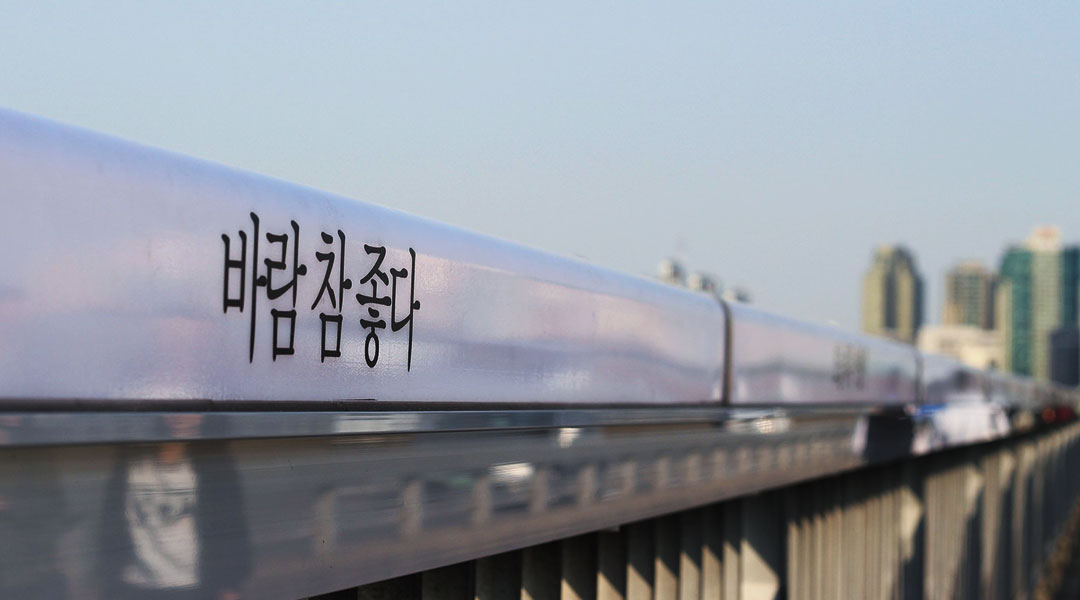Should our government think about putting more money into creating urban spaces and structures like Seoul’s Mapo Bridge?
(TW: This post mentions suicide.)
Seoul has a skyline of modern, breathtaking architecture. From immaculate office skyscrapers to endless high-rise apartments and contemporary architecture, to the hanok (traditional wooden house) and decorative temples, the capital city of South Korea has several notable structures that can easily grasp our sights and connect with people who visit their spaces. The Mapo Bridge in particular is a point of focus. A bridge spanning up to 1400 meters long and 24 meters wide, it is a great spot to take in the iconic views of Han River and Seoul.
READ MORE: Anthology Festival 2021: Adapting Architecture That Brings Us Together In A Time of Separation

This spot has not always been a spot of beauty, however. Sadly, it has been known for being one of the most famous suicide spots in Seoul. In order to try and spin the stigma away from the bridge, the Samsung Life Insurance & Seoul Government started “The Bridge of Life” campaign in 2012. This involved writing messages on the LED-lit guard railings which light up once someone walks past them. These messages which were chosen by psychiatrists and aim to reduce tension) include short and simple greetings, words of encouragement, and even jokes that try to communicate with anyone who has been thinking of suicide.
READ MORE: Architecture during the tuberculosis outbreak and what we can learn from it today
The increased publicity of the bridge increased the number of suicide attempts in 2013—a worrying piece of information, however, of these 93 attempts, 85 of those attempts were curbed. The city government also enhanced its suicide prevention efforts, installing more CCTV monitoring and a surveillance system alongside higher fences with mirrors on the 500-meter lookout platform of the bridge and attached detection sensors that prevent falls. With this consistent monitoring, the survival rate of suicide attempts soared to 94.6% from 60% during 2012.
In hindsight, structures and designs like the ones created for Mapo Bridge are heartwarming ways to wake someone from a daze of negative thoughts. Fences and nets are the basic prevention methods, of course, but sometimes, even simple greetings and short encouraging messages can leave an impact on someone struggling with difficult problems in life.
READ MORE: Beauty Beyond Brutalism: Inside the Historic Architecture of PICC

Mental health issues have become a cloud over our heads since this pandemic started. It might already be a chewed-up fact but many of us have been in our own heads for a while now and some people have been having trouble dealing with their own anxieties. According to a report, this problem with mental health issues didn’t mean a rise in suicide cases in many of the wealthy countries but unfortunately for the Philippines, this is not the case. According to a recent report from the Philippine Statistics Authority (PSA), deaths due to suicide increased to 3529 in 2020, a number that is 25.7% higher than 2019’s 2808 cases.
READ MORE: The Future of Ecological Living: Neri Oxman on Melanin and Material Ecology
Experts say that these deaths were the result of heavy pandemic fatigue which had become distressing enough to increase helpline calls, fully booked consultations, and more de-stressing activities. Aside from the issue of prolonged isolation, over 420,000 Filipinos fell into despair after losing their jobs last 2020.
The pandemic has opened up a plethora of harrowing issues that are difficult for anyone to handle and sometimes, mental health professionals who can help curb depressive thoughts are unreachable due to the endless quarantine extensions.
A look into Seoul’s Bridge of Life has poked at our thoughts. Maybe our government could start funding more projects similar to the Bridge of Life.
READ MORE: Lighting Healthy Spaces: Interview with Jinkie de Jesus



